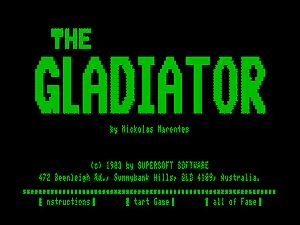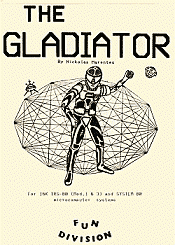 The Gladiator is a futuristic version
of the Roman fighting arenas. Your goal is to survive each round of fighting
in an arena enclosed in an energy barrier. Outside this barrier are cannons
that track your movements and fire at you. You need to destroy them by puncturing
a hole in the energy barrier with your Tobo Sphere and then send it into
one of the four cannons. Inside the arena are combat droids. As you progress
through each round, you will be placed against a higher level combat droid.
These droids mutate down to a previous level with each direct hit of your
Tobo Sphere until they are finally destroyed. The Gladiator is a futuristic version
of the Roman fighting arenas. Your goal is to survive each round of fighting
in an arena enclosed in an energy barrier. Outside this barrier are cannons
that track your movements and fire at you. You need to destroy them by puncturing
a hole in the energy barrier with your Tobo Sphere and then send it into
one of the four cannons. Inside the arena are combat droids. As you progress
through each round, you will be placed against a higher level combat droid.
These droids mutate down to a previous level with each direct hit of your
Tobo Sphere until they are finally destroyed.
The inspiration for The Gladiator was the Walt Disney movie, "Tron" starring
Jeff Bridges and Bruce Boxleitner. The movie was a bit of a flop to those
expecting another "cutTesy" Disney movie but the die hard computer nerds of
the day fell over backwards for it and today has become a bit of a cult classic.
The sound in this game is awesome! After playing it again after so many years,
I was blown over by the sound, especially considering the limited sound
capabilities of the TRS-80. I honestly believe that it left many of the games
on the other systems of the time for dead. The action was also frantic, carrying
the tradition I started with Neutroid.
Original Story Pretext
"The scene is a 21st century colliseum and the Gladiator is beamed into
the centre of the arena. But the sword and shield has now been replaced by
the Body Field and Tobo Sphere and where the Gladiator once fought with dangerous
animals and other skilled combatants, he is now involved with the deadly
ZENUS-5 series of muto-combat droids and tracker cannons. He prepares to
cast his Tobo knowing that he is outnumbered and that his opposition is
determined to have him down. Only speed, skill and quick wit will carry him
through the events."
Game Development
This game follows on with the philosophy of Neutroid but takes out the
abstractness and replaces it with a human character versus mutating battle
droids. It contains the same concepts as Neutroid, lots of complex sound,
fast and frantic action and a need for quick decision making.
As all the games prior to this, all programming was done using a cassette
based TRS-80 Model 1. I had to load the Editor/Assembler via tape (3 mins),
the assembly source code into it (up to 5 mins), key in my latest additions
and corrections (which were hand written first) then save the new source
code (up to 5 mins) and finally save a compiled binary (2 mins) after which
I could load the binary into memory (2 mins) and any graphics and sound table
data (2 mins) to see it run.... or fall in a heap if there were bugs. Very
time consuming but at the time, I hadn't experienced better and so it really
didn't bother me. The time waiting for data to load from the 500 baud cassette
was used to write up more code or work out a fix for a bug.
I did have one drama during this development period. I only had a 16K TRS-80
at the time and so I had run out of memory to hold the assembly source code
so I split the source into two separate blocks. One contained the common
subroutines while the other contained the main game code. Somewhere along
the line, one of the blocks on the cassette became corrupt and unreadable.
Luckily, I always kept two rotating copies of the code so I fell back a version
and just had to retype in the missing parts of the code.
Marketing and
Sales
 Gladiator was a great game although hard to master. It required a mastery
of the arrow keys on the keyboard used to move your character around the
arena. Sales were an improvement over Neutroid and I felt I was starting
have some success. Gladiator was a great game although hard to master. It required a mastery
of the arrow keys on the keyboard used to move your character around the
arena. Sales were an improvement over Neutroid and I felt I was starting
have some success.
The package art that I drew bears a resemblance to the electronic warriors
in "Tron" which as I mentioned, was the inspiration for this game.
I was proud of Gladiator. It was a good game with some neat animation and
fantastic sound effects. People were starting to see the quality in my games.
If I could have had a US distributor for this game, I believe it would have
been a big seller. Alas, living in Brisbane, Australia and no such thing
as the internet then, all marketing was confined to clubs and mail outs of
my newly created software catalogue to all my past customers. I guess I was
on the wrong side of the planet.
|